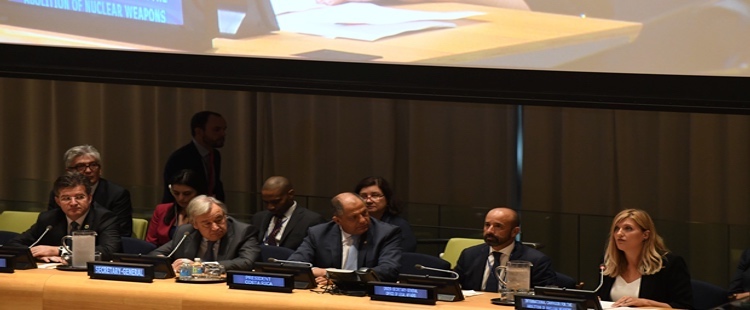By Thalif Deen
NEW YORK (IDN) — The United Nations has long held the dubious distinction of not practicing at home what it preaches to the outside world—whether it is racism in the UN system, inequities in high-level appointments or gender inequalities in its staff.
But it has proved its success at least in one particular field: its efforts to reduce its environmental footprint system-wide this time, not by design but by accident.
In its 2021 annual report “Greening the Blue”, the UN Environment Programme (UNEP), focuses on the environmental impact of over 315,000 UN staffers in New York, its field offices, and peacekeeping operations worldwide.
The data also includes inputs from 56 UN agencies and entities throughout the world.
And one of the key reasons for the reduced footprint is the “significant worldwide travel restrictions and large portions of UN personnel working from home” due to the coronavirus pandemic.
The UN system generated approximately 25 per cent fewer greenhouse gas emissions than in 2019, says the report.
“The steep reduction in emissions reflects the sudden and dramatic adaptation in operations that had to be made throughout 2020, as a result of the pandemic”.
At its headquarters in New York, the UN imposed a pandemic lockdown, beginning March 2020, with an overwhelming majority of staffers working from home. The 20-month lockdown is expected to be lifted November 15.
Referring to the findings in the report, UN Secretary-General António Guterres said: “Facing a triple planetary emergency—a climate crisis, a nature crisis and a pollution crisis—we need urgent and determined action from everyone, everywhere.”
The United Nations, he pointed out, is committed to lead by example in reducing our carbon and environmental footprint in all our operations around the globe.
“Together, let’s achieve a sustainable, net-zero and resilient world for all,” he added.
The Report provides UN system-wide data on the environmental impact areas and management functions identified in the Strategy for Sustainability Management in the United Nations System 2020-2030, Phase I: Environmental Sustainability in the Area of Management.
The Report is purely disseminated in digital form and is composed of three elements: a PDF, entity webpages and data tables.
The PDF focuses on the UN system-wide data, whereas entity-specific information is provided on the Environmental Performance Dashboard Annex, data tables and on each contributing entity’s greeningtheblue.org webpage. The 2021 edition of the Report covers 2020 data.
The highlights in the Report include:
Greenhouse gas emissions and offsetting
With significant worldwide travel restrictions and large portions of UN personnel working from home, the UN system generated approximately 25 per cent fewer GHG emissions than in 2019.
The steep reduction in GHG emissions reflects the sudden and dramatic adaptations in operations that had to be made throughout 2020, as a result of the global COVID-19 pandemic.
In 2020, the UN system produced approximately 1.5 million tonnes CO2eq, with per capita emissions of 5 tonnes CO2eq. The UN system’s emission by source were 32% from air travel, 55% from facilities, and 12% from other forms of travel. Of the reported 2020 emissions, 99% were offset.
The Report also includes, for the first time the GHG emissions trendlines, between 2016 and 2020, for each reporting UN entity. These trendlines reveal an overall reduction in GHG emissions generation was occurring across the UN system even prior to the operational adaptations due to COVID-19.
Additional Environmental Impact Areas
- The average waste generated for the whole UN system was 396 kg/person, this figure includes Peacekeeping and Special Political Missions wherein personnel live full time. If they are excluded, the average waste generated in 2020 was 184 kg/person. This is a reduction of 61 kg/person and 43 kg/person respectively from 2019.
- For 2020, the average water consumption was 38 m3 per UN personnel per year. This is an 11 m3 per UN personnel reduction from 2019.
Impacts of COVID-19
In 2020, there was still a substantial amount of work that could only be delivered in-person and required physical facilities and physical technologies. The Report highlights how several entities continued work to improve the environmental footprint of both their facilities and on the groundwork across different environmental impact and management areas.
Furthermore, in 2020, the COVID-19 pandemic imposed on many entities’ a radical change in work and travel patterns, the report notes.
However, this has also highlighted the opportunity the UN system has to revisit its working and travel modalities and come closer to the ambitious emissions reductions’ targets that it has set for itself for 2030. [IDN-InDepthNews – 08 November 2021]
The full Report and UN entity-specific data are available online at greeningtheblue.org.
Image credit: UNEP
IDN is the flagship agency of the Non-profit International Press Syndicate.
Visit us on Facebook and Twitter.
We believe in the free flow of information. Republish our articles for free, online or in print, under Creative Commons Attribution 4.0 International, except for articles that are republished with permission.

